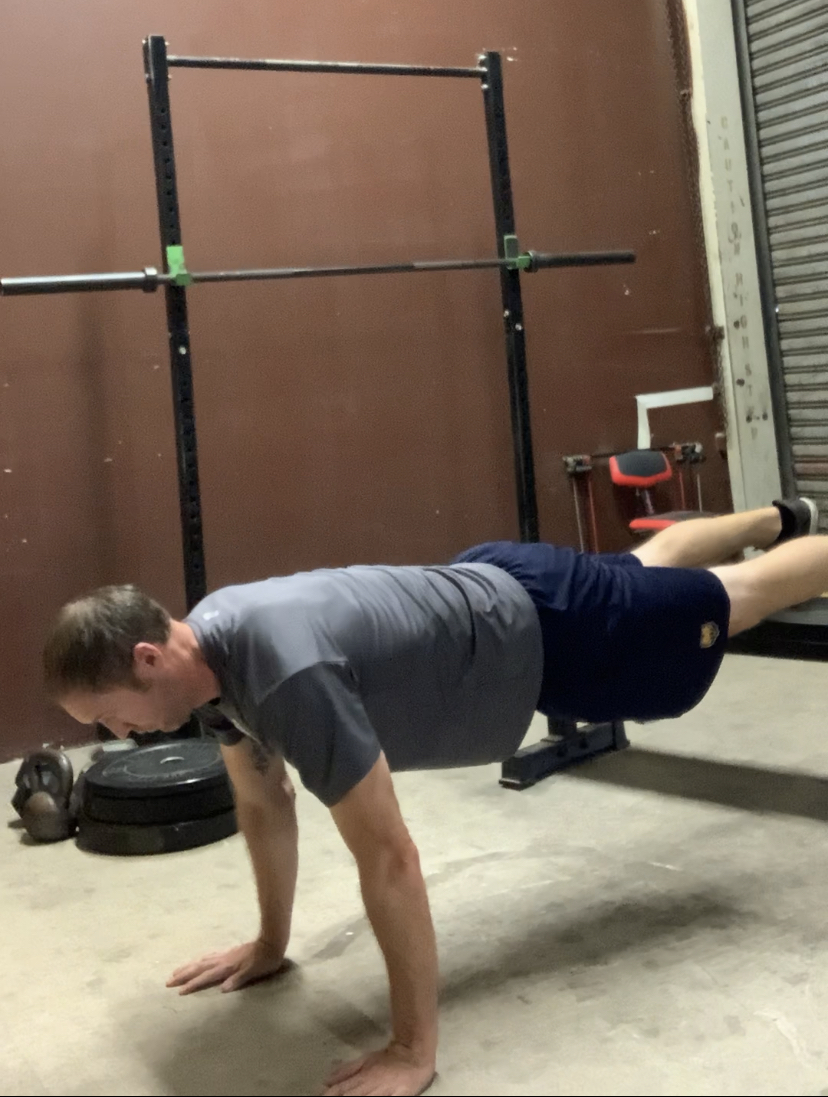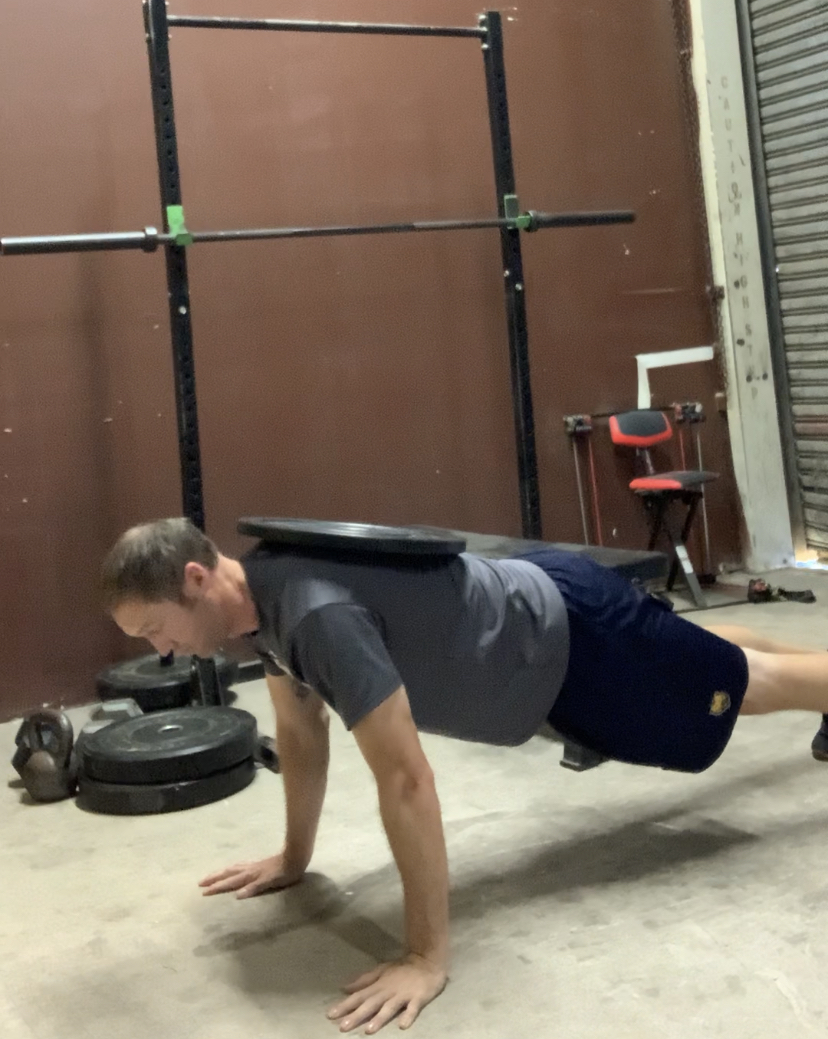T.O.’s Corner: Helping Handballers Become Fitter and Recover More Quickly
WPH Press, Tucson, AZ
By Travis Owen, MS, CSCS, PN1
When it comes to upper body pressing, I can’t think of a more beneficial exercise than the push-up. Generally, most people automatically think bench press for “strength,” but there are also plenty of ways to train for strength, rather than just endurance, with the push-up.
First, what’s the difference between strength and endurance? Well, muscular endurance is achieved through higher reps, which by default will require lighter weight, while strength is achieved through lower reps and higher amounts of weight. While you may think endurance is more important than strength for handball, that’s not necessarily the case because “endurance” is so specific to the demand of the movement. This principle is called “SAID,” or Specific Adaptations to Imposed Demands. Basically a fancy way of saying that the body will adapt to what it’s doing.
The best example I like to use for this involves baseball pitchers. The old school thinking used to be run distance to develop leg endurance. For pitchers to pitch an entire game, they need leg endurance, right? Well, it turns out that it doesn’t matter how many miles a pitcher logs in the running department, if they aren’t throwing around the same number of pitches in their bullpens/practices as they would be in games. The body can of course overachieve in some instances, but when it comes to preparation and long-term success, it’s important to build the “specific endurance” of actually throwing.
So with that said, can running for endurance hurt a pitcher? Well, for one, rather than muscle promoting, it’s generally catabolic. This is because there isn’t much resistance. Additionally, such an aerobic type of exercise is training more Type I, slower twitch muscle fibers, rather than the powerful Type II involved in throwing a pitch with maximal effort. What’s more important is to be stable and balanced when they deliver the pitch, and have their arm/body trained through bullpens to throw the proper amount of volume they will get in games.
Of course, handball isn’t the exact same as baseball- as it DOES require more aerobic endurance. However, I am of the camp that the endurance can be trained in more specific ways, like agility, sprinting/cutting/planting, and (as we don’t need to overthink this), playing handball. When it comes to resistance training, making sure we’re training for strength will help with producing more power, having more stability/balance, decreasing risk of injury, and being able to handle a higher workload.
All that considered, I like keeping most strength-type exercises that involve compound movements/many different muscle groups, under 10 repetitions. This of course means the movement needs to be made challenging enough so that the final rep isn’t so easy that we’re missing out on the benefit of strength training. In my experience training athletes, we’ve progressed their push-ups even as low as the 5 rep range, by weighting the movement and/or elevating the feet.
Many people think of basic bench pressing as the main “upper body push” strength movement, and I have heard many arguments for and against the bench press when it comes to handball. Generally, I think it’s more athlete dependent, and when I do program bench pressing for baseball/softball/handballers, I play it safe by going with dumbbells or kettlebells and using a neutral grip, or even floor presses if warranted.
Neutral Grip Dumbbell Bench Press HERE
1-Arm Dumbbell Floor Press HERE
However, I also love the push-up, as mentioned above, and think it’s superior due to a few different reasons:
1) More core recruitment.
2) Being a closed-chain upper body movement, this allows both proprioception from gripping the ground, as well as more rotator cuff stabilization- as it’s holding the entire body via the shoulder/ball in socket, rather than an open-chain movement such as a bench press where the humerus can drift.
3) Finally, it’s easier to get scapular freedom, since the shoulder blades aren’t pinned against a bench.
Again, I am certainly not anti-bench-press, as it all comes down to what the goals of the athlete are, and even the phase of training they are in (e.g. max strength/off-season, leading up to tournament prep, etc.), but the push-up is something that you really can’t go wrong with when it comes to shoulder health- so long as the form is correct.
We all have seen terrible push-up form, where the arms/elbows flare, the core drops, the chin comes forward, but what does it take then to achieve good form? First off, it requires solid core strength. This is one reason I’m a big fan of planks and variations that keep a neutral spine posture. These are much superior for both athleticism and back health than crunches and sit-ups. And they can easily be progressed to be tougher if they get too easy. Next, solid push-up form requires decent T-Spine mobility so that we’re not rounding the back too much, and/or substituting a head-forward posture for proper scapula retraction.
Finally, besides loading the push-up with weight or raising the feet for increased resistance (to potentially lower the reps and gain more strength), there are plenty of other variations that the basic push-up can be progressed to. I certainly wouldn’t recommend any of these until one can perform an excellent, “standard” push-up, controlling the hips and spine, keeping a neutral spine and maintaining good posture throughout the movement without flaring the elbows or reaching the neck forward.
Push-up Hold w/ T-Twist HERE
*Important to rotate at the T-Spine and not just simply lift the arm. Make sure to follow your hand with your head to open up and rotate at the T-Spine
Clap Push-ups HERE
*A good plyometric type exercise, as you need to generate enough speed & power to get the body into the air and remove/reposition the hands
1-Arm Push-up Holds HERE
*While not an actual range of motion push-up, it is a great exercise to train the shoulder to stabilize along with the opposite oblique. Make sure to keep the body in as straight of a line as possible so that you’re not rotating- this is where the added core stability comes into this movement
Travis Owen is the founder of his training service Travis Owen Performance (T.O. Performance) and has been involved with handball since picking it up in college in 2005. CSCS Certified through the National Strength & Conditioning Association and having earned his Master’s degree in 2011, Travis has been training individuals of all types for over 10 years. With an initial focus on softball & baseball athletes, Travis is starting to expand his reach to handball players and would like to elevate the game by providing articles and videos, as well as program design or training for anyone interested.
If you are looking for exercise programs or have any questions, contact Travis by email at owenperformanceTO@gmail.com, or visit travisowenperformance.com













